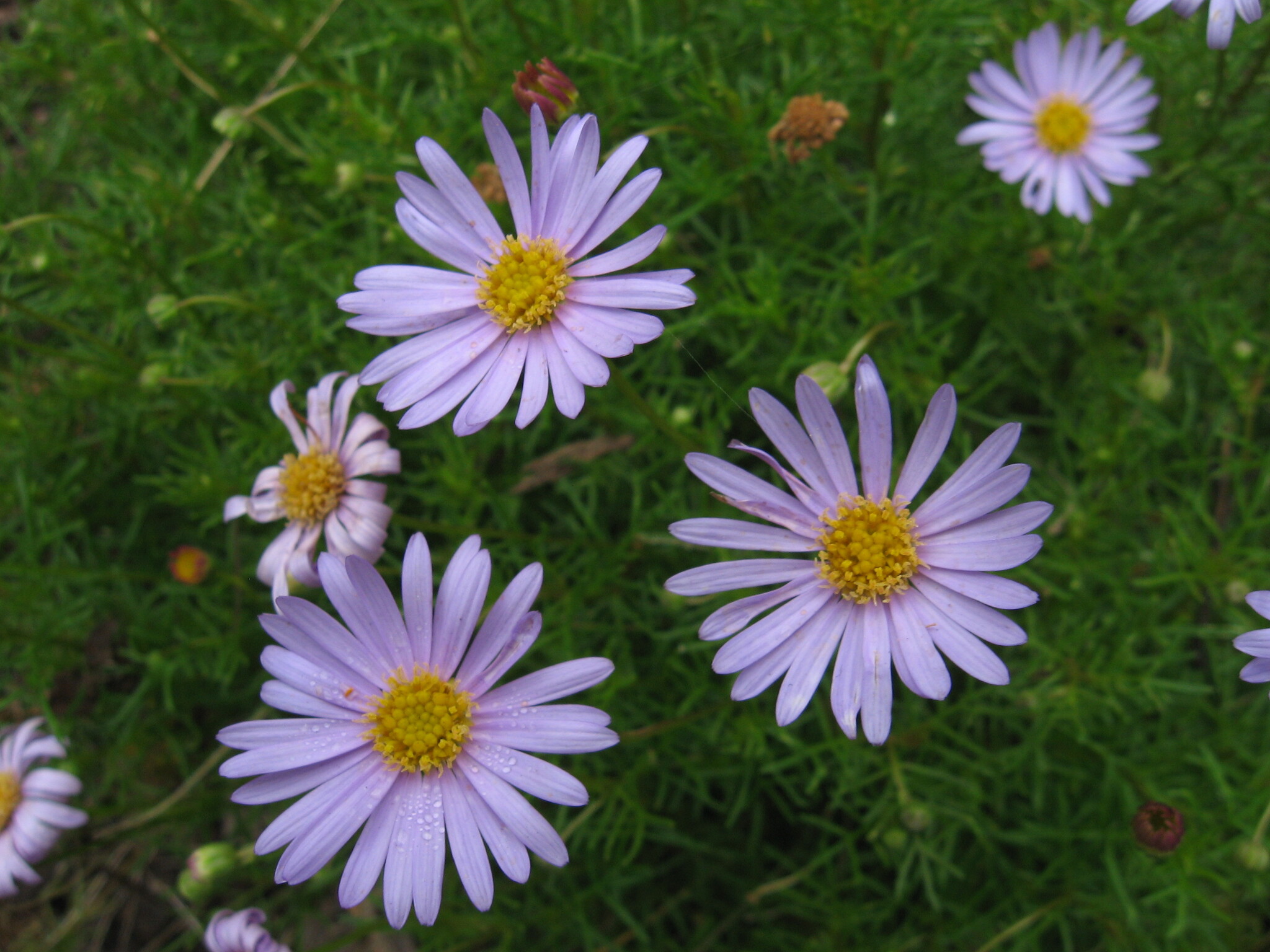
Greek brachys — short, kome — head of hair, an allusion to the short tufted pappus.
Annual or perennial herbs, rarely subshrubs. Stems erect or ascending, sometimes absent or very short. Leaves basal and/or along stems, alternate, entire to divided. Capitula radiate, terminal, solitary or in open corymbs, usually stalked. Involucral bracts in 1-4 (usually 2) rows, overlapping, almost equal or unequal. Receptacle sometimes pitted, convex to conical. Ray florets female, white, blue, pink or yellow. Disk florets mostly bisexual, yellow. Achenes variable, cylindrical or compressed, often ribbed or winged, glabrous or hairy, often warty. Pappus of 1 row of short scale-like bristles, sometimes absent. [Brachycome Cass.]
Many species have horticultural potential as border or rockery plants.
Some species with a rosette of basal leaves and poorly developed stem leaves are: B. diversifolia (Graham) Fisch. & C.A.Mey. from E Australia, a perennial herb to 45 cm tall with capitula to 3 cm across and solitary on long stalks, and white to mauve ray florets; B. heterodonta DC. from E Australia, an erect perennial herb to 50 cm tall with capitula to 2 cm across and solitary on long stalks, and white, bluish, orange or yellow ray florets; B. nivalis F.Muell. from high-altitude areas of SE Australia, a tufted perennial herb to 30 cm tall with capitula to 4 cm across and solitary on long stalks, and white ray florets; and B. spathulata Gaudich. from SE Australia, a tufted perennial herb to 60 cm tall with toothed leaves, capitula to 3 cm across and solitary on long stalks, and blue to mauve, rarely white ray florets.
Species with all or most leaves entire are: B. angustifolia DC. from SE Australia, a stoloniferous perennial herb to 35 cm tall with leaves mostly along the stems, capitula to 2.5 cm across and solitary on long stalks, and pink, blue or mauve ray florets (the var. heterophylla (Benth.) G.L.R. Davis has divided leaves); and B. basaltica F. Muell. from E Australia, a weakly rhizomatous perennial herb to 60 cm tall, with leaves mostly along the stems, capitula to 2.5 cm across and solitary on long stalks, and white ray florets.
Seed, cuttings and division.
Achenes often marginally ribbed or winged; pappus a tuft of short, scale-like bristles.
About 70 species, mostly from Australia, with a few species in New Guinea, New Caledonia and New Zealand.
Salkin et al. (1995).
Source: (2002). Asteraceae. In: . Horticultural Flora of South-eastern Australia. Volume 4. Flowering plants. Dicotyledons. Part 3. The identification of garden and cultivated plants. University of New South Wales Press.

New cultivars are continually appearing on the market - the following represents a selection of those of probable hybrid origin that have been available for several years.
Compact plant 15-20 cm tall with blue-mauve flowers 2.5-3.5 cm wide.
Originated from an Australian breeding program in the early 1990s and a presumed cross, B. angustifolia × B. multifida 'Breakoday'.
Compact habit 15-20 cm tall, the foliage sometimes purplish, with purple-pink flowers 3.5-4.5 cm wide.
Originated from a breeding program in Australia c. 1990 as a cross B. formosa 'Pilliga Posy'× B. segmentosa seedling.
25-30 cm tall. Flower heads 3-4 cm wide, deep to mid-mauve.
Derived from B. ascendens.
Brachyscome 'Strawberry Mousse'
Compact habit, 10-15 cm tall with spoon-shaped leaves and bright pink flowers 3-4 cm wide and spreading by suckering.
A presumed cross, B. angustifolia × B. formosa, that arose as a chance seedling in a nursery in southern Victoria.
30-35 cm tall. Buds yellow-brown, with yellow daisies 2.5-3 cm wide, fading to cream.
Arose as a chance seedling in the garden of a member of the Australian Daisy Study Group south of Brisbane.
10-15 cm tall. Flowers violet-blue, 2.5-3 cm wide, fading to cream for most of the year. ['Ultra']
Originated from breeding trials carried out in Germany as a cross, B. multifida seedling × B. rigidula.
20-30 cm tall with mauve-pink daisies 2.5-5 cm wide from spring to autumn.
Probably a cross, B. angustifolia var. heterophylla × B. segmentosa, that arose as a chance seedling in the garden of a member of the Australian Daisy Study Group south of Brisbane.